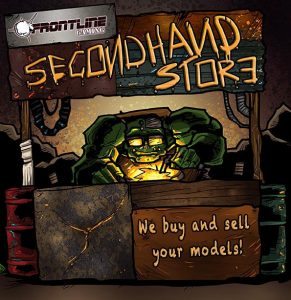Greetings, Mortals! Anvil here, and today, we are going to cover the concept of Modular Rules and how it can impact future tabletop games. For more reviews, bat reps and analysis, check out the Tactics Corner!
According to Wikipedia, “The term modularity is widely used in studies of technological and organizational systems. Product systems are deemed `modular’, for example, when they can be decomposed into a number of components that may be mixed and matched in a variety of configurations. The components are able to connect, interact, or exchange resources (such as energy or data) in some way, by adhering to a standardized interface. Unlike a tightly integrated product whereby each component is designed to work specifically (and often exclusively) with other particular components in a tightly coupled system, modular products are systems of components that are `loosely coupled.’” I bring up modularity because with the General’s Handbook coming out around the anniversary of Age of Sigmar’s release, I feel that out all the flaws and benefits, the mixing-and-matching of the rules is the game’s strongest aspect. I think there’s a lot of potential for other tabletop games to adopt this concept so that their products reach a wider audience.
How is Age of Sigmar Modular?
There are 4 pages that are included free online and in every book published since the release of AoS that form the base rules for playing the game. Then you have Time of War rules, Realm Battleground rules, triumph tables, Allegiance rules (in the new General’s Handbook, or GH from now on), Path of Glory, Points, Army Organization rules, Battleplans, etc. While the base rules are required to play the game, players can decide which, if any, additional rules they would like to include in the game. Some players really like the idea of themed-forces and want to use Allegiance rules. Some players can decide to include army building using points, and whether or not they want to follow the suggestions for army organization by meeting requirements for Battleline, Leader, Artillary, and Behemoth units. Others may want to change up the game by deciding to play in a certain Realm or Battleground in their Path of Glory campaign, but not worry about points for the purposes of telling a story. Brand new players may omit all optional rules so that they can learn the core rules. What’s important to realize about the setup the designers have when it comes to AoS rules is that each option is disconnected from other optional rules, allowing the players to mix and match until they have what they need to play.
What is Good About Modularity?
Modularity focuses on 2 main aspects: Scalability and Standardization. Scalability allows systems to handle increased content and unpredictable growth plans. Standardization allows for quick deployment, simplified planning and design, and easier testing. Basically, Standardization is all about efficiency while Scalability is about flexibility. A much more complex game system takes a very long time to develop and test, as whenever a rule is changed, you have to test the entire game to make sure it works in conjunction with the other rules already established. Not only that, you then have to check to make sure that the addition does not conflict with another rule already in place. If that occurs, you then have to decide which takes priority, or if they can even interact with each other.
Once a ruleset becomes large and complicated enough, then it becomes increasingly difficult to make additional content or rules that players would like to use. When Death from the Skies came out, several players at my store gave it a shot in several games. But since then, they have not used the additional phase included in the book. When I asked them why, it wasn’t because they didn’t like how it worked, but instead that it was too many things to keep track of and that it bogged down the pace of the game. Most games that have a complex set of rules, while more “complete”, prevents a lot of customization for players to incorporate into their games. Talking with the players at my FLGS, they tend to avoid additional rules for 40k because it’s already time consuming enough and that managing additional rules becomes a chore. With AoS, the core rules are simple enough that players discuss which optional rules they like to run with the most, and then stop when they feel it becomes too much to keep track of.
What Are the Negatives to Modular Rules?
One of the downsides to the Modular Rules is that you have to buy additional books to access new releases. With more complex games, players tend to be happy with buying just one or two books and not having to worry about picking up anything else. Fortunately, GW has embraced modern technology and came out with the AoS app. They have also offered a form of “micro transaction” where instead of buying the whole book, you can buy that individual set of rules for a small price. This also helps with organizing such rules instead of having several books laid out and spending time finding them using the “My Battle” link.
Modular rules are also a double-edged sword in that you need to discuss with your opponent or tournament organization which ones to use. While you can negotiate with your opponent on which rules will satisfy you both, there will be times where you can’t include everything you want, for the sake of actually getting to play the game. There are some optional rules that will naturally be much more popular in general, while others sort of sink to the bottom and are rarely used.
Was This Intentional Design?
I personally do think that the concept of picking and choosing additional rules for your games was intentional on GWs part. Shortly after the game was released, their first book contained Time of War rules, battleplans, and rules for fighting in the Brimstone Peninsula. They made it clear that you could fight using one, all, or none of the rules included in the book. They later came out with the Path to Glory campaign rules near the release of Archaon, which was very well received. A lot of the stores in my area loved it so much that they had to write up their own tables and rewards for other factions to use. GW heard the feedback, and decided to include other allegiances for Path of Glory in the General’s Handbook. The inclusion of Keywords on the warscroll acts as a node for other future rules to reference. Keywords follows the Standardization and Scalability aspects of modularity because it organizes (allegiances, races, class, etc), and allows for the units to be affected by unpredictable changes. For example, if there’s a new terrain piece that benefits Priests, they don’t have to go back to previous warscrolls and make changes, nor do they have to list the models specifically by name.
I think the inclusion of points was not in the original plans, and decided to include it when they contacted the players that developed their own points system. I think they were experimenting to see if they could make the game work without it. They heard the customers enough to realize that a lot of players still like using points and unit limits to get a better gauge on game balance. When AoS did come out, I wish they had conveyed more clearly that they planned to include a lot of optional rules in the future. The only thing they mentioned was that their were going to be a ton of Battleplans for players to use.
How Can This Affect Other Games In the Future?
Modular games allow for a more broad appeal to customers as well as giving them a longer shelf life for a fraction of the cost. We have seen this happen elsewhere for games like Undercity, Mansions of Madness, or Super Dungeon Explore. However, they focused more on different game scenarios, expanding character choices, and board tiles being interchangeable. But games like Mansions are very complex rules-wise to the point where it didn’t really gain a following until someone started posting tutorial videos on youtube of how to play the game, making it difficult for most people to get into it such as the younger crowd or those that don’t have a lot of time to spare, like working parents. For this to work, games should release with a very simple rule set to get players playing. The reason for that is because it’s easier to make a game more complex, rather than making it simpler. It’s like cooking: you can only add ingredients, not remove them (for the most part).
Once you feel like you have a good understanding of the game, then there could be a booklet or cards along with the game that give you optional rules to play with. Special abilities depending on which character you use or their stats/keywords, additional obstacles on the board depending on the terrain, dice rolling replaced with actual puzzles involving game pieces, introducing a “Fog of War” mechanic instead of laying out all of the tiles at once, etc. A simpler game could allow you the time to play a quick match during a lunch break or with your younger cousin, while the optional rules can be included for a weekend with friends around your age group, using the rules you enjoy and think you can handle. What’s really important to take into consideration is how to break up optional rules from core rules, which AoS does very well. The core rules are separate from all other optional rules physically, and they don’t include excerpts right in the middle of explaining a game mechanic with “if you like, you can opt to do blah blah at schmim schmar time”. That can confuse a lot of players when they have to reference rules quickly, or knowing which rules you can ignore and which ones you must know.
Conclusion
Modularity is a great system to go by when it comes to game design. It can make it easier for game designers to organize and expand on their products, allow for more accessibility for customers and players, and increase appeal through choosing which rules you enjoy playing with the most. What optional rules have you found yourself playing with? What would you like to try? What has not been working for your group?
As always, share your thoughts in the comments section! And remember, Frontline Gaming sells Games Workshop product at up to 25% off, every day.










A well designed game should be a mostly closed system that has been planned with a concept ahead of time. Modular is just another word for unfinished and scattered.
40k is currently a hot mess of rules no one knows how to find and no one is happy with that. It doesn’t lower the barrier of entry, it makes it almost impossible for a new player to even know what is going on.
A wonderful example would be player who actualy read the whole corebook and their codex, come prepared to a game just to find out their Stormraven doesn’t actualy have Skyfire like they thought because the newest sourcebook told them so.
Or that the other player has yet another formation from yet another new book with new psychic powers they never heard of.
If the systems were designed to scale that would be an entirely different thing. They could create different play levels that use different amounts of rulesets. But that’s not what GW does. Their approach isn’t as much modualr as “throw out something unfinished and then dump more stuff onto it at random later”.
To stay with Age of Sigmar, someone could read their four page rulebook but still be nowhere until they also read the general’s handbook. I don’t have handy examples from there but I’d be pleasantly surprised if the design was any less of chaotic than their usual work.
This response does not make sense to me. What do you mean by the player being “nowhere until they also read the general’s handbook”? Could you find me examples of what you mean by that?
Let’s asume Player A has read the 4 Page rulebook, bought the basic box (and I dunno 500 Bloodthirsters, whatever) and thinks “Sure I know this game now”. Goes to a store and meets player B. Player B has been at it for a while, follows forums, is part of the local community.
Player A: Hey! Let’s have a game!
Player B: Sure? How about say a thousand points?
Player A: What are points?
Using points as the example I know and asuming the other types of matches also have rules, otherwise I’m not sure what exactly that book says about them. Anyway the point being that you’ll end up having to catch up with rules all over the place.
I think this comment basically skimmed what the author wrote and assumed he was referring to 40k.
The point of this is describing a shift in game design philosophy that is not present in 40k. 40k is unfinished and scattered and not modular. It attempts to be all things to no one in particular (reference: unbound armies, the Jervis Johnson rule, inclusion of Apoc/escalation in the BRB etc.)
Sigmar attempts to create different streams of gaming based on a single core rule set – you can then agree to use different versions as you see fit. Use of keywords allows different rules to apply to groups of unit types. Unlike 40k where you have to figure out what types of space marine qualify as a “space marine”.
For example, generals handbook + core rules is all you need to organize a pick up game at a store. Whereas the author describes in detail the issues around DFTS.
That’s the difference. It’s a totally different approach to 40k’s bloated mess.
(I am also tremendously fond of that bloated mess, for the record.)
This being the internet I can’t realy blame you for asuming I missed the huge “Age of Sigmar:” but the article specificaly asumes that sort of rules as a possibility for all wargaming and my point is that they are a mess.